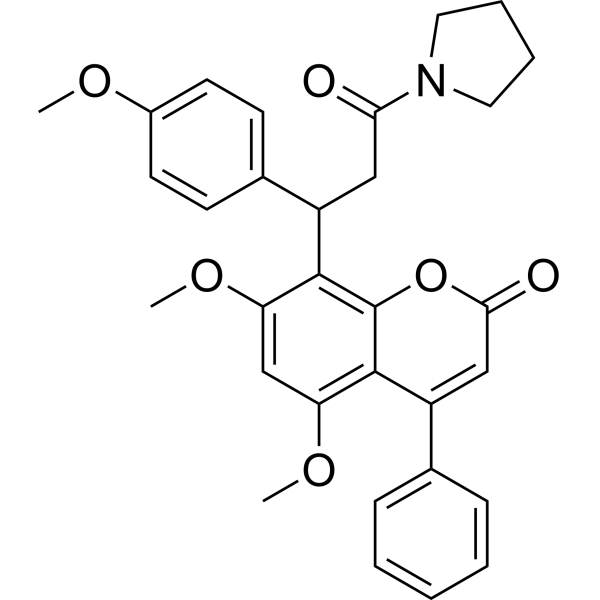Physicochemical Properties
| Molecular Formula | C31H31NO6 |
| Molecular Weight | 513.58 |
| Exact Mass | 513.215 |
| Elemental Analysis | C, 72.50; H, 6.08; N, 2.73; O, 18.69 |
| CAS # | 958843-91-9 |
| PubChem CID | 16746438 |
| Appearance | White to off-white solid powder |
| Density | 1.2±0.1 g/cm3 |
| Boiling Point | 741.3±60.0 °C at 760 mmHg |
| Flash Point | 402.1±32.9 °C |
| Vapour Pressure | 0.0±2.4 mmHg at 25°C |
| Index of Refraction | 1.606 |
| LogP | 5.59 |
| Hydrogen Bond Donor Count | 0 |
| Hydrogen Bond Acceptor Count | 6 |
| Rotatable Bond Count | 8 |
| Heavy Atom Count | 38 |
| Complexity | 839 |
| Defined Atom Stereocenter Count | 0 |
| InChi Key | PROGRNRRJJYCNX-UHFFFAOYSA-N |
| InChi Code | InChI=1S/C31H31NO6/c1-35-22-13-11-21(12-14-22)23(17-27(33)32-15-7-8-16-32)29-25(36-2)19-26(37-3)30-24(18-28(34)38-31(29)30)20-9-5-4-6-10-20/h4-6,9-14,18-19,23H,7-8,15-17H2,1-3H3 |
| Chemical Name | 5,7-dimethoxy-8-(1-(4-methoxyphenyl)-3-oxo-3-(pyrrolidin-1-yl)propyl)-4-phenyl-2H-chromen-2-one |
| Synonyms | 958843-91-9; CMLD-2; MLS000879470; SMR000465530; CMLD2; CMLD 2 |
| HS Tariff Code | 2934.99.9001 |
| Storage |
Powder-20°C 3 years 4°C 2 years In solvent -80°C 6 months -20°C 1 month |
| Shipping Condition | Room temperature (This product is stable at ambient temperature for a few days during ordinary shipping and time spent in Customs) |
Biological Activity
| Targets | HuR[1] |
| ln Vitro | CMLD-2 (1-75 μM; 24-72 h) suppresses the viability of thyroid cancer cells [2]. In H1299 and A549 cells, CMLD-2 (20–30 μM; 24-48 h) activates caspases and causes apoptotic cell death [3]. In H1299 and A549 cells, CMLD-2 (30 μM; 24-48 hours) causes mitochondrial disruption and G1 cell cycle arrest [3]. In H1299 cells, CMLD-2 (30 μM; 24-48 hours) decreases HuR and HuR-regulated mRNA and protein expression [3]. The directional migratory capacity of SW1736, 8505C, BCPAP, and K1 cells is decreased by CMLD-2 (35 μM; 72 hours). MAD2 mRNA levels in SW1736, 8505C, BCPAP, and K1 cells can be markedly decreased by CMLD-2 [2]. |
| Cell Assay |
Cell Viability Assay[2] Cell Types: SW1736, 8505C, BCPAP and K1 cells Tested Concentrations: 1, 5, 10, 25, 35, 50, 75 μM Incubation Duration: 24, 48, 72 hrs (hours) Experimental Results: decreased the viability of all the four cell lines when used at 35, 50 and 75 μM concentration and at different time points. Apoptosis Analysis[3] Cell Types: H1299, A549, H1975, HCC827, MRC-9 and CCD16 cells Tested Concentrations: 20, 30 μM Incubation Duration: 24, 48 hrs (hours) Experimental Results: Marked activated the caspase-9 and -3 in lung tumor cells. Induce the cleavage of PARP in lung tumor cells. Dramatically increased the annexin-V-positive staining in lung tumor cells. Cell Cycle Analysis[3] Cell Types: H1299, A549, MRC-9 and CCD16 cells Tested Concentrations: 30 μM Incubation Duration: 24, 48 hrs (hours) Experimental Results: Induced greater G1 phase cell cycle arrest in H1299 and A549 cells than in MRC-9 and CCD16 cells. Western Blot Analysis[3] Cell Types: H1299, A549, H1975, HCC827, CCD16 and MRC-9 cells Tested Concentrations: 20, 30 μM Incubation Duration: 24, 48 hrs (hours) Experimental Results: Diminished protei |
| References |
[1]. Identification and validation of novel small molecule disruptors of HuR-mRNA interaction. ACS Chem Biol. 2015 Jun 19;10(6):1476-84. [2]. The HuR CMLD-2 inhibitor exhibits antitumor effects via MAD2 downregulation in thyroid cancer cells. Sci Rep. 2019 May 14;9(1):7374. [3]. HuR-targeted small molecule inhibitor exhibits cytotoxicity towards human lung cancer cells. Sci Rep. 2017 Aug 30;7(1):9694. |
Solubility Data
| Solubility (In Vitro) | DMSO : 50 mg/mL (97.36 mM) |
| Solubility (In Vivo) |
Solubility in Formulation 1: ≥ 2.5 mg/mL (4.87 mM) (saturation unknown) in 10% DMSO + 40% PEG300 + 5% Tween80 + 45% Saline (add these co-solvents sequentially from left to right, and one by one), clear solution. For example, if 1 mL of working solution is to be prepared, you can add 100 μL of 25.0 mg/mL clear DMSO stock solution to 400 μL PEG300 and mix evenly; then add 50 μL Tween-80 to the above solution and mix evenly; then add 450 μL normal saline to adjust the volume to 1 mL. Preparation of saline: Dissolve 0.9 g of sodium chloride in 100 mL ddH₂ O to obtain a clear solution. Solubility in Formulation 2: ≥ 2.5 mg/mL (4.87 mM) (saturation unknown) in 10% DMSO + 90% (20% SBE-β-CD in Saline) (add these co-solvents sequentially from left to right, and one by one), clear solution. For example, if 1 mL of working solution is to be prepared, you can add 100 μL of 25.0 mg/mL clear DMSO stock solution to 900 μL of 20% SBE-β-CD physiological saline solution and mix evenly. Preparation of 20% SBE-β-CD in Saline (4°C,1 week): Dissolve 2 g SBE-β-CD in 10 mL saline to obtain a clear solution. Solubility in Formulation 3: ≥ 2.5 mg/mL (4.87 mM) (saturation unknown) in 10% DMSO + 90% Corn Oil (add these co-solvents sequentially from left to right, and one by one), clear solution. For example, if 1 mL of working solution is to be prepared, you can add 100 μL of 25.0 mg/mL clear DMSO stock solution to 900 μL of corn oil and mix evenly. (Please use freshly prepared in vivo formulations for optimal results.) |
| Preparing Stock Solutions | 1 mg | 5 mg | 10 mg | |
| 1 mM | 1.9471 mL | 9.7356 mL | 19.4712 mL | |
| 5 mM | 0.3894 mL | 1.9471 mL | 3.8942 mL | |
| 10 mM | 0.1947 mL | 0.9736 mL | 1.9471 mL |
